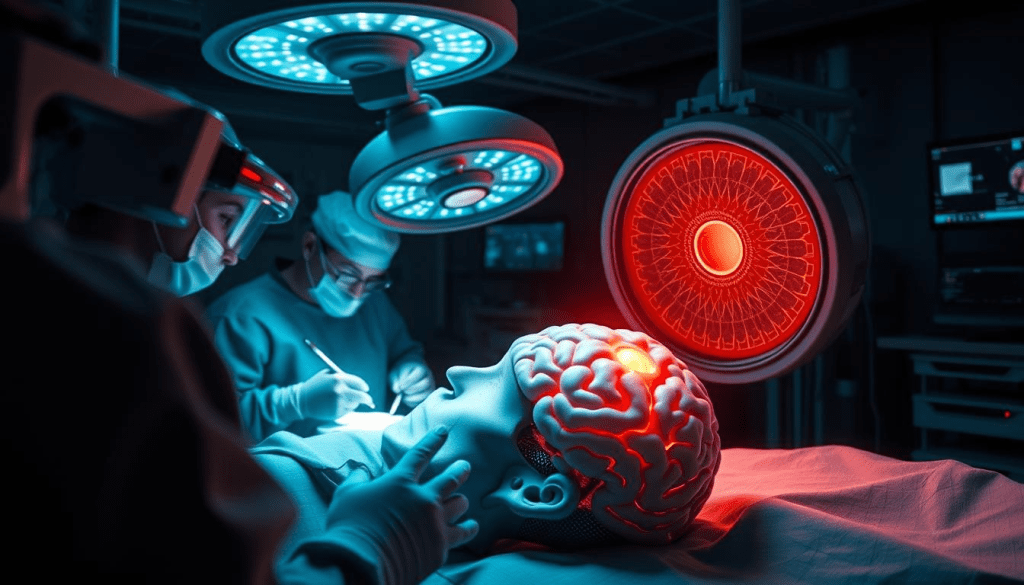Last Updated on November 27, 2025 by Bilal Hasdemir

brain tumor therapy
Managing brain tumors needs a detailed plan, using the newest treatments. At Liv Hospital, we focus on the patient, using the latest therapies to give hope to those with this disease.
New ways to treat brain cancer are emerging, like new surgeries, radiation, and chemotherapy. Our team works hard to give each patient care that fits their needs.
Key Takeaways
- Advanced treatment options are available for effective brain tumor management.
- A patient-centered approach is key to personalized care.
- New surgeries and radiation are making treatments better.
- Chemotherapy plans are made just for each person.
- Comprehensive care is vital for complex diseases.
Understanding Brain Tumors and Their Impact

A detailed brain scan displaying a large, irregularly-shaped tumor pressing against the surrounding neural tissue. The image should be rendered in a clinical, diagnostic style, with a focus on the internal structures of the brain. The lighting should be cool and directional, creating sharp shadows that emphasize the tumor’s distinctive shape and location. The background should be a neutral, muted color that does not distract from the primary subject. The overall composition should convey a sense of medical objectivity, allowing the viewer to clearly understand the nature and extent of the brain tumor.
It’s key to know about brain tumors for good care and treatment. These tumors can be either benign or malignant. The type, size, and where they are in the brain help decide how to treat them.
Types of Brain Tumors and Their Classifications
Brain tumors are sorted by where they come from and how they grow. The main types are gliomas, meningiomas, and acoustic neuromas. Gliomas start from the brain’s glial cells and can be low-grade or high-grade (glioblastoma).
Meningiomas are usually not cancerous and grow from the meninges. These are the protective layers around the brain.
Common Symptoms and Diagnostic Approaches
The signs of brain tumors can vary a lot. They depend on where, how big, and how fast the tumor grows. Symptoms include headaches, seizures, changes in thinking, and problems with nerves.
Doctors use MRI and CT scans to see the tumor’s details. These scans help find tumors early.
The Importance of Early Detection and Treatment
Finding and treating brain tumors early is very important. Quick action can ease symptoms, stop the tumor from getting worse, and make treatments work better. Treatments can be surgery, radiation, chemotherapy, or a mix of these.
It’s vital to have a treatment plan that fits the patient. Knowing the tumor’s details helps doctors create a better plan. This can greatly improve the patient’s quality.
The Evolution of Brain Tumor Therapy

A detailed, evolving visualization of brain tumor treatment methods over time. In the foreground, advanced surgical tools, lasers, and robotic devices showcase modern neurosurgical techniques. The middle ground depicts cross-sections of the brain, illuminating the progression of imaging and targeting capabilities, from early CT scans to the latest MRI-guided procedures. In the background, a timeline of research and clinical breakthroughs unfolds, from chemotherapy and radiation to groundbreaking immunotherapies and gene therapies. The scene is bathed in a warm, hopeful light, symbolizing the continual refinement of brain tumor management for improved patient outcomes.
Brain tumor treatment has changed a lot over time. This change comes from new medical tech and learning more about tumors. We’re making progress in treating brain tumors, thanks to these advances.
Historical Approaches to Brain Tumor Treatment
At first, doctors mainly used surgery to treat brain tumors. They tried to remove as much of the tumor as they could. But early surgery was limited by old technology, leading to mixed results.
The start of radiation therapy was a big step forward. It was a non-surgical way to target tumor cells more accurately.
Chemotherapy came later, adding another way to fight tumors. But early chemo had problems like not getting past the blood-brain barrier and bad side effects.
Paradigm Shifts in Treatment Methodologies
Our understanding of brain tumors has grown, changing how we treat them. We now know about different tumor types and their unique traits. This knowledge has led to more targeted treatments.
Using diagnostic imaging and molecular diagnostics has helped doctors tailor treatments for each patient. This move towards personalized medicine is a big change.
New treatments like immunotherapy and targeted molecular therapies have come up. These new methods offer hope for treating tumors that old treatments couldn’t touch.
The Move Toward Personalized Medicine
Personalized medicine is a big step in treating brain tumors. Doctors use genetic profiles and molecular diagnostics to tailor treatments. This approach targets tumor cells more precisely, which might lead to better results and fewer side effects.
Personalized medicine in brain tumor treatment uses advanced diagnostics, targeted therapies, and new ways to deliver treatments. As we learn more about tumors, we’ll see even better treatments for patients.
Surgical Interventions: Precision and Innovation
Modern brain tumor surgery is all about precision and innovation. It brings new hope to patients. We’ve seen big steps forward in treatments, making them more effective and less invasive.
Advanced Neurosurgical Techniques
Modern neurosurgery uses advanced techniques to improve results. Microsurgery lets surgeons remove tumors carefully, keeping healthy tissue safe. It uses high-powered microscopes and special tools for precise work in the brain.
Neuronavigation systems also play a big role. They give surgeons real-time feedback, making surgeries more accurate and safer.
Minimally Invasive Surgical Approaches
Minimally invasive surgery has changed neurosurgery a lot. It lets surgeons do complex work through small cuts. This method causes less damage, less scarring, and faster healing for patients.
Endoscopic surgery is another key technique. It lets surgeons see and reach tumors through natural openings or small cuts. This means fewer big cuts in the skull.
Intraoperative Imaging and Navigation Systems
Intraoperative imaging and navigation systems are key in brain tumor surgery today. They offer real-time imaging during surgery. This helps surgeons remove tumors more accurately and safely.
By combining advanced imaging with navigation, we can make brain tumor surgeries more precise and effective.
Radiation Therapy Advancements
New developments in radiation therapy are making treatments for brain tumors more precise and effective. This leads to better results for patients. We see big steps forward in this area, with new methods to better target brain tumors.
Stereotactic Radiosurgery (SRS)
Stereotactic Radiosurgery (SRS) is a precise radiation therapy. It gives a high dose of radiation to a specific spot, harming less of the healthy tissue around it. This method works well for small to medium-sized brain tumors. It’s also non-invasive, which means less recovery time.
SRS is great for tumors that are hard to get to with surgery. It’s also good for patients who can’t have traditional surgery. Its high precision makes it a key tool against brain tumors.
Intensity-Modulated Radiation Therapy (IMRT)
Intensity-Modulated Radiation Therapy (IMRT) changes the intensity of the radiation beam. This lets doctors give a precise dose to the tumor, while protecting the healthy tissue around it.
IMRT is useful for tumors that are hard to shape or are close to important areas. It tailors the treatment, which can lead to better results and fewer side effects.
Proton Beam Therapy
Proton Beam Therapy (PBT) is a big step forward in radiation therapy. It uses protons to kill cancer cells, unlike traditional radiation. Protons’ unique properties allow for precise radiation delivery, with less damage to healthy tissue.
PBT is great for tumors in sensitive areas, like the brain. It’s precise, making it a good choice for some brain tumors.
These new radiation therapy methods show our ongoing work to improve brain tumor treatment. With SRS, IMRT, and PBT, we can offer more personalized and effective treatments to patients.
Innovative Chemotherapy Approaches for Brain Tumors
New ways to use chemotherapy are changing how we fight brain tumors. Chemotherapy is key in treating brain tumors. Research is ongoing to make drugs work better and reach tumors more easily.
Blood-Brain Barrier Penetrating Agents
One big problem with brain tumor treatment is the blood-brain barrier (BBB). It blocks many drugs from getting to the tumor. Scientists are working on BBB-penetrating agents to get drugs past this barrier.
These agents help drugs get to the brain tumor better. They can cross the BBB. This opens up new ways to treat brain tumors.
Temozolomide and Other First-Line Treatments
Temozolomide is a common drug for some brain tumors, like glioblastoma. It stops cancer cells from growing by messing with their DNA.
Other treatments might mix different drugs. The choice depends on the tumor type, grade, and the patient’s health. Each treatment plan is unique, showing how complex brain tumor care is.
| Chemotherapy Drug | Primary Use in Brain Tumors | Mechanism of Action |
| Temozolomide | Glioblastoma, Anaplastic Astrocytoma | An alkylating agent damages the DNA of cancer cells |
| Carmustine (BCNU) | Various brain tumors, including glioblastoma | An alkylating agent interferes with DNA replication |
| Lomustine (CCNU) | Brain tumors, including glioblastoma and medulloblastoma | An alkylating agent affects DNA synthesis |
Localized Chemotherapy Delivery Systems
Localized systems are another new way to treat brain tumors. They deliver drugs right to the tumor, reducing side effects and increasing drug levels.
Polymer wafers soaked in drugs are placed in the tumor after surgery. They slowly release the drug, keeping the tumor exposed to it for a long time.
These new methods are making brain tumor treatment better. They give patients more effective and targeted treatments.
Immunotherapy: Harnessing the Body’s Defenses
Immunotherapy is changing how we treat brain tumors. It uses the body’s immune system to fight cancer. This method has shown great promise in treating brain tumors.
Checkpoint Inhibitors in Brain Tumor Treatment
Checkpoint inhibitors are drugs that help the immune system fight cancer. They work by removing the brakes on the immune system. This lets it target and destroy cancer cells more effectively.
Key benefits of checkpoint inhibitors include:
- Enhanced immune response against cancer cells
- Potential for improved survival rates
- Application in various types of brain tumors
CAR T-Cell Therapy Applications
CAR T-cell therapy is a new way to fight cancer. It involves changing a patient’s T-cells to attack cancer cells. This treatment has shown good results in some brain tumor cases.
The process of CAR T-cell therapy involves:
- Extracting T-cells from the patient’s blood
- Genetically modifying these cells to produce CARs
- Infusing the modified T-cells back into the patient
The Promising ‘Fusion Superkine’ for Glioblastoma
Researchers are looking into ‘Fusion Superkine’ for glioblastoma treatment. This therapy aims to make the immune system better at targeting glioblastoma cells.
Potential advantages of Fusion Superkine include:
- Targeted approach to glioblastoma treatment
- Potential for improved treatment outcomes
- Innovative mechanism of action
As we keep working on these treatments, we’re getting closer to better brain tumor care. The future of treating brain tumors looks bright with these immunotherapy advances.
Targeted Molecular Therapies in Brain Tumor Management
Advances in precision medicine have changed how we treat brain tumors. These therapies target the molecular mechanisms that drive tumor growth. This approach offers a more personalized and effective treatment.
Precision Medicine and Genetic Profiling
Precision medicine has changed oncology, allowing us to tailor treatments to each patient’s genetic profile. Genetic profiling of brain tumors helps identify specific mutations. This makes treatments more effective and reduces side effects.
For example, genetic testing can show if a tumor has a mutation that makes it susceptible to a certain therapy. Knowing the tumor’s genetic makeup helps us choose the best treatment. This improves patient outcomes.
Tyrosine Kinase Inhibitors and Growth Factor Targeting
Tyrosine kinase inhibitors (TKIs) are key in brain tumor management. TKIs block specific tyrosine kinases involved in tumor growth. This can slow or stop tumor growth.
Growth factor targeting is another strategy. Some brain tumors are driven by overexpressed growth factors. Therapies targeting these factors can halt tumor progression.
| Therapy Type | Mechanism of Action | Clinical Application |
| Tyrosine Kinase Inhibitors | Inhibit tyrosine kinases involved in tumor growth signaling | Used in treating brain tumors with specific genetic mutations |
| Growth Factor Targeting Therapies | Block growth factors promoting tumor angiogenesis and proliferation | Applied in cases where tumors overexpress certain growth factors |
Anti-Angiogenic Therapies
Anti-angiogenic therapies target angiogenesis, key to tumor growth and metastasis. These therapies inhibit new blood vessel formation. This can starve the tumor of nutrients and oxygen, causing it to regress.
“The use of anti-angiogenic agents has shown promise in the treatment of glioblastoma, a highly vascularized and aggressive form of brain tumor.”
” Expert Opinion
Bevacizumab is an example of an anti-angiogenic drug used in brain tumor treatment. It targets vascular endothelial growth factor (VEGF), a key mediator of angiogenesis.
In conclusion, targeted molecular therapies are a big step forward in brain tumor management. They use precision medicine, genetic profiling, and targeted therapies. This offers more effective and personalized treatment options to patients.
Emerging Technologies in Brain Tumor Therapy
The field of brain tumor therapy is changing fast with new technologies. These advancements are making treatments better and more tailored to each patient. We’re moving towards treatments that are more effective and personalized.
Focused Ultrasound for Enhanced Drug Delivery
Focused ultrasound is a new tech that helps drugs reach brain tumors better. It uses sound waves to open up the blood-brain barrier. This lets drugs get to the tumor more easily, without surgery.
Benefits of Focused Ultrasound:
- Non-invasive procedure
- Enhanced drug delivery to the tumor site
- Potential for improved treatment outcomes
Tumor Treating Fields (TTFields)
Tumor Treating Fields (TTFields) is a new way to fight brain tumors. It uses electric fields to stop tumor cells from growing. A special device sends these fields to the tumor.
TTFields has been shown to:
- Disrupt tumor cell division
- Inhibit tumor growth
- Improve patient survival in certain cases
Laser Interstitial Thermal Therapy (LITT)
Laser Interstitial Thermal Therapy (LITT) is a new surgery that uses lasers to kill tumor cells. It’s guided by MRI, so it can target tumors accurately. It’s great for tumors that are hard to reach.
Advantages of LITT:
- Minimally invasive procedure
- Precise targeting of tumors
- Reduced risk of damage to surrounding brain tissue
These new technologies are big steps forward in treating brain tumors. As research keeps going, we’ll see even more ways to help patients.
Comprehensive Brain Tumor Management: The Multi-Disciplinary Approach
Managing brain tumors requires a team effort from many medical experts. We think a team approach is key for effective care. This ensures patients get the best treatment.
Tumor Boards: The Backbone of Treatment Planning
Tumor boards are essential for planning treatments. They bring experts together to discuss and plan care for each patient. This teamwork makes sure all parts of a patient’s health are covered, leading to better treatment plans.
At our place, tumor boards include neurosurgeons, oncologists, and radiologists. They review patient data, talk about treatment options, and make decisions together.
Integrating Supportive Care and Rehabilitation
Supportive care and rehabilitation are key parts of brain tumor management. We know patients need more than just medical treatment. They also need emotional and psychological support.
Our supportive care includes pain management, nutrition advice, and mental support. These services aim to improve patients’ lives. Rehabilitation helps patients get back to their daily activities and independence.
Liv Hospital’s Patient-Centered Care Model
Liv Hospital’s care model focuses on each patient’s unique needs. This model highlights the importance of a team working together for personalized care.
We use the latest medical tech and a caring approach to help our patients get the best results.
Conclusion: The Future of Brain Tumor Treatment
The field of neuro-oncology is making great strides. This means better treatments for brain tumors are on the horizon. Patients with brain tumors now have more hope than ever before.
Doctors are using a team approach to fight brain tumors. This includes surgery, radiation, and new medicines. These methods are showing great promise in helping patients.
We’ve made big steps in understanding and treating brain tumors. But finding a cure for all brain tumors is a big challenge. Researchers are working hard to find new ways to fight the disease.
Can we cure brain cancer? It’s a tough question. The answer depends on the tumor type and stage. But with new medical tech and knowledge, the outlook is getting better.
Hospitals like Liv Hospital are focusing on patient care. They offer support to those fighting brain tumors. As we go forward, new tech and treatments will be key in treating brain tumors.
FAQ
What are the treatment options for brain cancer?
Can brain tumors be cured?
What is the role of immunotherapy in brain tumor treatment?
How is brain cancer treated?
What are the benefits of targeted molecular therapies in brain tumor management?
What is the significance of early detection in brain tumor treatment?
How do you treat a brain tumor?
What are the emerging technologies in brain tumor therapy?
Can you cure brain cancer?
What is the role of a tumor board in treatment planning?
References
- Congress of Neurological Surgeons. (2025). The role of emerging therapies in the management of patients with metastatic brain tumors. https://www.cns.org/guidelines/treatment-adults-metastatic-brain-tumors/guidelines-treatment-of-adults-with-metastatic-bra-2
- Bianco, J., et al. (2025). Recent advances in diagnosis and treatment of brain tumors. Frontiers in Neurology, 16, 1606149. https://www.frontiersin.org/articles/10.3389/fneur.2025.1606149/pdf






